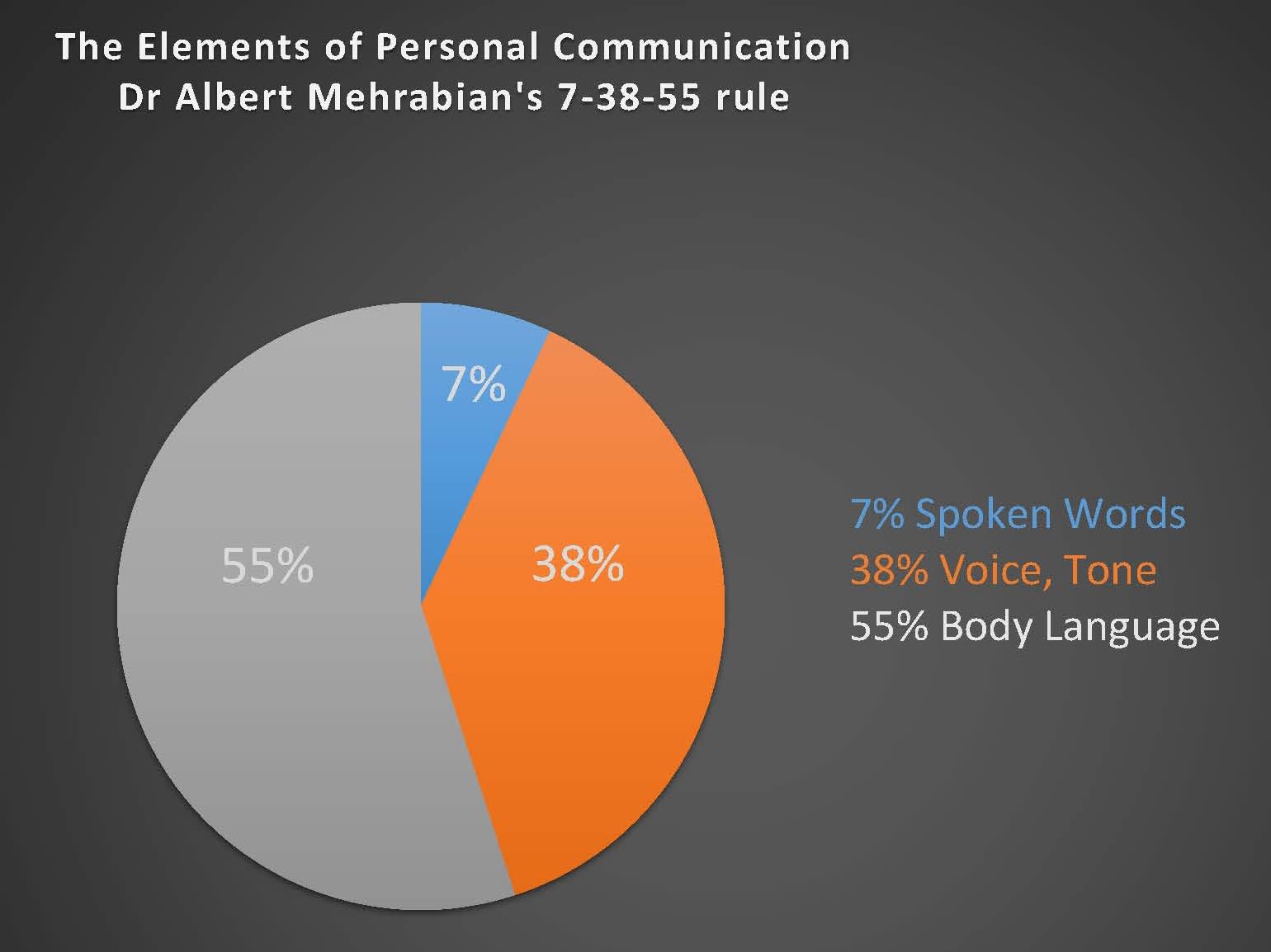Non-Verbal Communication: Body Language
Experiential Education

Overview
What will you learn?
- The importance of body language
- The elements of personal communication and what we 'say' with our bodies
- How to send the right message with CLEAR body language

The Importance of Body Language
Elements of Personal Communication
Science tells us that perhaps over ninety percent of what we communicate is nonverbal. One well-known study in the late 1960's was by Albert Mehrabian, who suggested the 7-38-55 rule:

Diagram sourced and adapted from Belludi (2008)
Diagram sourced and adapted from Belludi (2008)
This does not mean that what we say is less important or less heeded than how we say it, but it can make a difference to how our words are interpreted by their receiver.
While it is wrong (and in many places, illegal - see the module called Discrimination by ‘Lookism’) to judge people, and employ people, on the basis of how they look, it is a fact that we do take our bodies to work, and what we communicate to others nonverbally may be interpreted differently from what we are communicating verbally. Whether we are employers or employees, and especially when we take on a leadership role, we need to be aware of our own bodies, how we are presenting them, and what they are communicating to others. We also need to be aware of other people’s bodies, what they are telling us, and how we treat them.
| Nonverbal communication can play five roles: | |
|---|---|
Repetition:
|
|
Contradiction:
|
|
Substitution:
|
|
Complementing:
|
|
Accenting:
|
|
| Source: | The Importance of Effective Communication, Edward G. Wertheim, Ph.D. |

Getting the full story: body language, or nonverbal communication
What we say to each other in words is not all that we are saying. This is how Kris Cole (2013, pp. 123-24) explains it:
How you say something is usually more important than the words themselves. People receive an enormous amount of information, often subconsciously, through non-verbal signals: a wink, a nod, a smile, a gesture, a yawn, silence. Your gestures, tone of voice, the way you stand and your facial expression all add to (or detract from) your words. Whether or not you intend to or are even aware of it, you also communicate through the clothes you wear, your facial expressions, tone of voice and other forms of non-verbal communication and body language.
Of course, what we present to others can also be influenced by other outward signs, such as our clothes, hygiene, manners and mannerisms, and tone and volume of voice. Once we are aware of ourselves (and our selves) and how we present ourselves to the world, we can adapt to benefit different situations.

Types of Nonverbal Communication
There are many ways that we express ourselves nonverbally, from our facial expressions to the proximity of our bodies. As you review the list of nonverbal elements, reflect on your use of each element in your communication interactions (e.g. are you aware of how you use the particular element? Do you use the nonverbal feature effectively? Do you find certain elements below challenging?)
(hover over or tap on the tiles to see more information)
Facial expressions

Our face communicates a huge proportion of nonverbal communication. Even before we speak, our face is carrying a message. Unlike gestures and body language, facial expressions are similar throughout the world
Body movement and posture

Your body movement includes elements such as how you sit, stand, and move. It encapsulates the angle of your body and the placement of your arms (e.g. across your body or open)
Gestures

Consider the gestures you make through conversations and, importantly, how those gestures could be interpreted cross-culturally
Eye Contact

The way and length of time that you look at someone communicates many aspects, including your interest or disinterest in what they are saying
Touch

Messages and meaning can be communicated through the way that you shake hands or pat someone on the back. It can communicate power, status or concern and care.
Space

This includes the amount of distance between parties in the conversation, which depends on things such as situational factors and context (e.g. business or personal), level of familiarity and social/cultural norms.
Voice

Also called paralinguistics, voice includes elements such as the tone, volume, pace, pitch and pause.
Appearance

This feature involves your choice of clothes, colours and hairstyles. Appearance can play an important role in first impressions and how you are perceived.

Being aware of our own bodies
How can we use this understanding to help us present ourselves to others, and ensure that our body is communicating the same message as what we are saying verbally? Cole (2013, p. 125) suggests that it is ‘SO CLEAR’. Here’s how to make sure your body language supports your communications:
Body Language is So Clear!
Here's how to make sure your body language supports your communications:
(Click the hotspots for more information)
(Cole 2013)
Emotional awareness means being alert to the nonverbal communications of others, as well as ourselves. When we enter a conversation with heightened emotions, we need to be aware of what our nonverbals are communicating. Similarly, when in conversations with others, we can become more emotionally-aware by:
- Paying attention to the nonverbals and the unspoken message they might be communicating
- Pay attention to inconsistencies or mixed messages between what they are saying and what their nonverbals are communicating
- Avoid overanalysing a single nonverbal (e.g. eye contact), but consider nonverbals as a group dynamic
- Trust your instincts
(Segal et al 2020)
Before viewing the video resources below, try this short quiz on reading body language:
We as good communicators can also be conscious of the subtleties of body language in others. Cole’s (2015, p. 125) SO CLEAR strategy, shown above, can be used to help us ‘diagnose’ how others are feeling, for example: bowed or erect posture; blushing or blanching; clenched fists or open hands. We can then adapt ourselves to best benefit the other person. Conversely, we can learn to recognise such symptoms in ourselves, and adjust ourselves accordingly.

Resources
Videos of Interest
In one of the most popular TED Talks Amy Cuddy (2012) suggests that not only can our mind affect our body, but our body can affect our mind. Specifically, she suggests that we can use our body to ‘fake it ‘til you become it’ and that standing in a posture of confidence can boost our feelings of confidence – even if we don’t feel confident.

References
Belludi, N 2008, ‘Albert Mehrabian’s 7-38-55 rule of personal communication’, 4 October, viewed 9 June 2017, <http://www.rightattitudes.com/2008/10/04/7-38-55-rule-personal-communication/ >.
Cole, K 2013, Management theory and practice, 5th edn, Pearson, Frenchs Forest.
Cuddy, A 2012, ‘Your body language may shape who you are’, TEDGlobal, viewed 1 June 2017, <https://www.ted.com/talks/amy_cuddy_your_body_language_shapes_who_you_are
>.
Edward, L 2004, ‘Making hijab part of police uniform’, The Age online, 27 November, viewed 1 June 2017, <http://www.theage.com.au/news/National/Making-hijab-part-of-Victoria-Police-uniform/2004/11/26/1101219743263.html
>.
Segal J, Smith M, Robinson L and Boose, G 2020, Nonverbal Communication and Body Language, HelpGuide, viewed 18 January 2022, <https://www.helpguide.org/articles/relationships-communication/nonverbal-communication.htm>.
Sinclair, A 2007, Leadership for the disillusioned: moving beyond myths and heroes to leading that liberates, Allen & Unwin, Sydney.
---- 2011, ‘Leading with body’, in Jeanes, EL, Knights, D & Martin, PY (eds), Handbook of gender, work, and organization, Wiley, Hoboken, pp. 117-30.